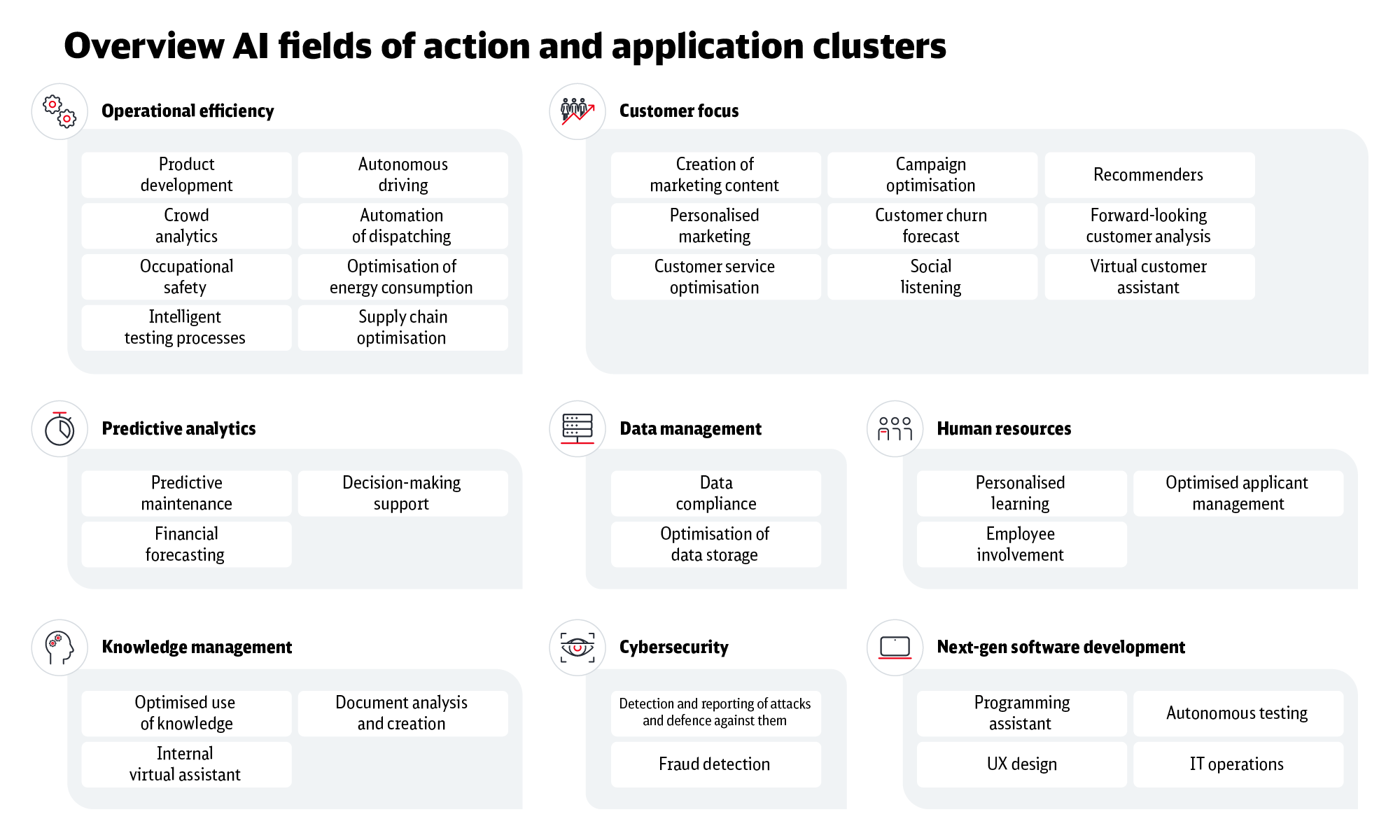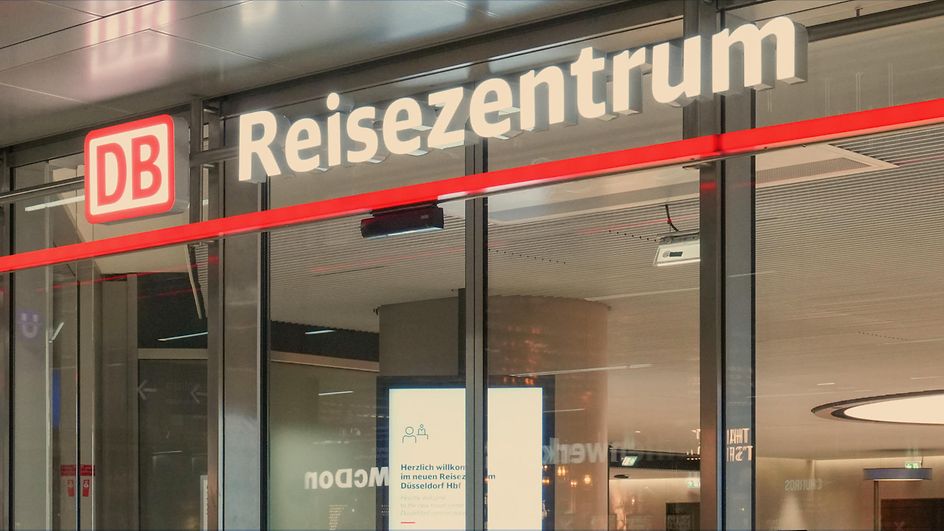AI in long-distance transport at Deutsche Bahn
Article: An AI roadmap for greater reliability and profitability in long-distance transport
03/2025 – Artificial intelligence facilitates precise forecasts of demand or proactive maintenance. AI therefore plays a key role in Deutsche Bahn's digitalisation strategy for long-distance transport. A new roadmap defines relevant fields of action along the value chain and their implementation in specialist areas.
Railway companies have always used new technologies to improve their operations and performance. So artificial intelligence (AI) is also a very promising area for rail transport. "AI, and generative artificial intelligence (GenAI) in particular, helps to improve planning and performance along the entire value chain," says Axel Schulz, Head of AI and the Data Intelligence Center at DB Fernverkehr. AI projects have been in existence at DB Fernverkehr since as long ago as 2015. DB Systel supports AI projects in long-distance transport, for example with advice and tests for IT security.
A new strategic AI roadmap from the IT and digitalisation division at DB Fernverkehr now offers a perspective on key, broadly applicable AI areas of action for the entire business division. According to a recent study by UIC and McKinsey, rail companies worldwide can save between USD 13 and 22 billion per year by using AI (PDF). The enormous potential of AI is demonstrated by another study by Sopra Steria Next. Experts estimate that the global AI market will account for ten per cent of global IT spending by 2028 and will grow three times faster than the technology market overall.
Pilot projects by European rail companies
A look outside the box already reveals value-adding examples of the use of AI in European rail transport. At SBB AG in Switzerland, for example, demand forecasts are prepared with the aid of AI in order to allocate the appropriate number of freight wagons. An AI-supported driving profile also allows precise calculations of time and speed. At SCNF AG in France, an AI solution ensures that capacity utilisation and revenue for the high-speed trains (TGV) are optimised. In future, the cognitive performance of staff will also be monitored using artificial intelligence: Measurements of eye movements, perspiration and heart rate can reduce accidents by revealing stress and fatigue levels among the personnel.
Deutsche Bahn, too, has already implemented a number of AI use-cases. The spectrum here ranges from the Railmate feedback platform and Peak Spotting, an intelligent capacity utilisation control system, to forecasts of delays based on artificial intelligence. Deutsche Bahn has launched the S3, a refurbishment programme aimed at greater punctuality, reliability and economy. Digitalisation and the use of AI in the right places are helping to achieve these goals. In addition, the spread of GenAI opens up new potential on a daily basis.
Analysing the market and competition
In order to systematically exploit this potential, DB Fernverkehr AG has identified possible fields of action for AI in the coming years in a structured manner. The first step on this path was to better understand the market and the use of AI: What AI applications are other companies using - from Rolls-Royce to Unilever and Coca-Cola? Meanwhile, the potential benefits of these use cases for DB Fernverkehr AG were categorised - for example, whether the use cases contribute to punctuality, efficiency and customer satisfaction.
At the same time, the team analysed twelve competitors in the mobility industry to find out which use cases are already adding value in those companies. This market and competition analysis resulted in eight broadly applicable fields of action for the use of AI, each with the most promising clusters of applications:
The most important fields of action for rail operations
Market analysis promises great AI potential for a wide range of industries. For DB Fernverkehr, it was important to determine the areas that could realistically be implemented and that offered the greatest possible added value. The second step was to look at the specific needs of rail companies. Interviews with experts from research and industry as well as rounds of discussion with internal and external partners helped to identify specific clusters of applications that will be most relevant in the coming years.
"When implemented successfully, AI helps to optimise processes, develop new business models and strengthen competitiveness."

This includes, for example, automated dispatching of trains and predictive maintenance for optimised maintenance of trains, tracks and signalling systems. Based on the market analysis and the expert interviews, the team drew up a list of recommendations for the most relevant AI fields of action for the coming years. Although the market sees and realises AI potential in a wide variety of fields, clear recommendations can be made for rail companies regarding focus areas aimed at relevant key performance indicators such as punctuality, quality, profitability and customer satisfaction.
AI fields of activity with the highest commercial potential
| Field of action | Description | Field of action examples | ||
|---|---|---|---|---|
| Automation of dispatching | Real-time resource planning | Detecting and resolving conflicts | Connection scheduling and delay decisions | Worklist prioritisation |
| Creation of marketing content | Create and customise content using AI | Create images | Generate texts | Create complete assets |
| Customer service optimisation | AI-supported interactions and solution finding with customers | Automate cancellations in customer service | Automate ordering processes | Automate service processes on the train |
| Optimised use of knowledge | Faster access to relevant information | Agent-based access and utilisation of knowledge sources | Make regulations available to addressees in a targeted manner | Provide information in a context-sensitive and proactive manner |
| Predictive Maintenance | Needs-based maintenance planning to avoid downtimes | Early detection of damage | Early detection of contamination | Improve condition monitoring |
| Supply chain optimisation | Improved requirements planning and accelerated supply chain processes | Optimise warehouse planning | Optimised delivery processes | Improved requirements planning |
From the field of action to company-wide economy of scale
Based on these fields of action, the "AI in long-distance transport" programme is currently working with the specialist departments to identify specific and feasible practical use cases. "In our opinion, a holistic approach is crucial for this – one that keeps an eye on feasibility and technical benefits, as well as regulatory aspects," says Axel Schulz. In order to avoid isolated solutions and break down existing silos, broadly applicable technical objectives are needed for each field of action that affect many specialist areas. This creates the basis for implementing more complex applications: "If the implementation is successful, AI helps to optimise processes and workflows at relevant points and thus boost competitiveness."
In addition, the right framework conditions must be created to enable sustainable economy of scale. This includes clear responsibilities and processes, efficient implementation and uniform technological standards. Typical challenges include improving data quality and dealing with fragmented data sources - while at the same time ensuring data protection. Last but not least, staff training is an essential step in scaling AI across the board.
Conclusion: Step by step introduction of AI
With the use of AI and GenAI, railway companies are facing a new technological era that can significantly improve efficiency, reliability and customer satisfaction. With clearly prioritised fields of action such as predictive maintenance, automated dispatching and customer-oriented content creation, companies can create added value along the entire value chain. A holistic approach that guarantees realisability, interdisciplinarity and scalability is crucial for success. If companies succeed in implementing AI sustainably, they will not only strengthen their operational efficiency, but also their competitiveness in an increasingly dynamic mobility market.



